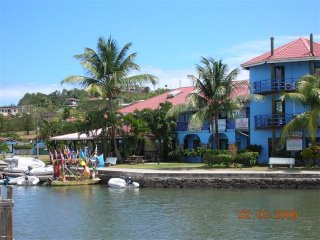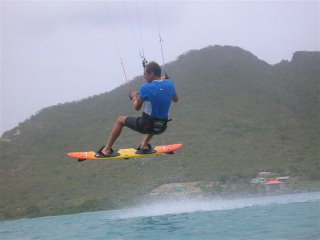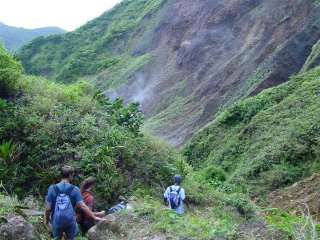Tuesday, March 28, 2006
Its been a while since we blogged. Pina Colada gently rocked us from the island of Martinique to St Lucia (Rodney Bay, Marigot Bay then the Pitons), past the island of St Vincent to Bequia (Admiralty Bay), the uninhabited island of Baliceaux for two nights, Tobago Cays then to Union Island where we anchored her in Frigate island bay for a week of concentrated kite surfing.
Rodney Bay Marina where we polished the topsides

We have been busy. In Rodney Bay Marina we cleaned and polished the topsides. We were a little stung by Kennedy, the local West Indian man who we hired to help us. There is no quality assurance when you hire someone straight off the dockside. We soon leaned, after he put his polishing rag down for good that he wasn’t a labourer at all, he was a musician, and he kindly give us his CD. From here we sailed the 15 miles or so to the Pitons. On coming into the bay of Soufriere we were T-boned by a boat-boy who got the throttle stuck on this 75 horse power outboard whilst planing in his fibreglass 20 foot open boat. The boat-boys in St Lucia will zoom up to you and ask if you need mooring assistance or a tour guide. They often have bread, crayfish or fruit and veggies for sale. We were extremely lucky he didn’t hole the hull or ride up and kill me; instead he banged the cap rail hard and dented a stanchion. We had no recourse
SY ‘Helen Victoria’. The top of the Petit Piton (on the left) on St Lucia afforded Nick and I dizzying views.

The Pitons are a well known land mark and part of a National Park; they are two incredibly steep mountains that emerge from clear deep water (either side of Jalousie cove) upwards to about 2500 feet. It costs $US50 to climb the Gros Piton, but the park guides won’t take tourists up the steeper and more treacherous Petit Piton. There is a twisted scrambling track to the top of it though, with roped sections for the otherwise impossible faces, and someone has planted a flag at the top. Nick and I found this little path and it took us 2.45 hours to summit and get back down totally burnt out. That was a fun time (which made up for being rammed).
A typical place to call home

The next island southbound was St Vincent.. This island is the ‘erb’ growing capital of the Caribbean (A$150/pound), From the boat sailing past this island its possible to see ganja farms with randam rows of ‘christmas tree’ like plants – its so extensive. We hitched up to Trinity Falls and wandered throught the giant bamboo groves with Carl and Tanya off “Helen Victoria”. From St Vincent the gunja is trafficked out to all over the islands and the USA. It is not a violent drug but it strikes me in these places where Rastafarianism is a culture rather than a religion that a lifetime of smoking has some serious side affects. I have tried to communicate with many Rasta’s, on many occasion they really don’t know the difference between stop and pause. In Soufriere on St Lucia (and in other towns) we noticed quite a few “crazy” homeless looking older men staggering around. Mentally ill people living in poverty, squatting near the rocky esplanades, doing some begging from time to time if a tourist passes by. Couldn’t think of a nicer environment to waste your life though, and the majority of people are genuinely polite and friendly. The crazy guys are an accepted part of the scenery.

We wandered into Soufriere on a Sunday. Life in the village seemed pretty good. As is often the case, the most central house, the one near the communal washhouse and water supply tap, was blaring out reggae from what must have been a colossal speaker stack, the women were hanging the freshly washed clothes out on the power lines that sag into each shanty home, and the kids were getting their clothes filthy again taking turns being dragged around by the dog’s tail etc. It’s colourful and we never felt edgy about our safety in any of the islands despite the groups of loitering extremely well built black men.
The ‘family unit’ in the Windward isles is a rangy concept - the locals are proudly and overtly promiscuous. The local calypso music campaigns rampant morals on every radio station. (Pious Patti was shocked by the lyrics!) In the local magazines and on radio male role models, be they aged famous musicians or politicians are proud that they have “12 or maybe 14 children” by as many different women. I asked a church group outing of young children on the beach how many brothers and sisters they each had. They had to think hard about it and most had more than eight. Someone told me the HIV rate is about 50% which does not surprise me. But then it makes sense to have very many brothers in the hood.
Dinner for two and Tobago Cays

Further south in the Grenadines, we spent 2 nights anchored on our own at an uninhabited island, Baliceaux, the first since we were in the Canary islands. In 1795 the Carib Indians, who had mixed for a couple of generations with a load of shipwrecked African slaves, surrendered after months of bloody fighting with the British and 5000 of them were exiled to Baliceaux. A little later they were loaded onto a convoy of eight vessels and transported to the coast of Honduras, where the winds prevented their ever returning. Now there are only goats and two skinny cows at Baliceaux. The island is very dry and eroded. The poisonous or prickly species are persisting under such uncurtailed grazing. Immediately south lies the privately owned island named Mustique, famed as the playground for the ‘ultra rich’. We gave this island much searoom.
From Baliceaux we waddled downwind on a rough sea and tucked in behind the horseshoe reef that protects the Tobago Keys. A cluster of four tiny uninhabited islands surrounded in crystal clear blue water makes the most picturesque place to anchor. The anchorage is shallow (10 feet) over uniform white sand so that it looks like your anchored in an endless swimming pool (with about 40 other yachts).
Kiting at Frigate island

There we met ‘Helen Victoria’, sailed from Oregon by Carl and Tanya, and Top Cat with three Californians on board, Bruce, Star and Johnnie. We are all of a similar age which is slightly anomalous given the broader cruising demographic. Carl and Tanya’s kiteboarding enthusiasm is contagious and now we are living solely to kite. After two nights at Tobago Keys we sailed with the other two boats to Frigate Island and nestled into a routine of kiting, gathering on one or the other of the boats or on the beach for drinks, then reclining at home till the wind came the following day.
Carl and Nick were out getting one last kite boarding session in before sunset. A band of local youths were preparing a fish feast on the beach. They told me conch soup was very good for your back. From out of the steaming pot of snapper and shellfish on the open fire a big chewy piece of conch which was lifted. It was delicious and it improved my niggly back tremendously (although kite surfing helped too I’m sure). The narrow beach was built up with conch shells that had been collected over decades and boiled up just like the meal I shared.
Collecting grapefriut with a farmer and May the donkey

The little island of Petit Martinique was as far south as we ventured before turning north again to make Antigua before Louise and Garry arrive for race week (whoo hooo), one of the biggest yachting event in the Caribbean which will undoubtedly will be splendidly lavish and pandemonium at the same time. Carl and Tanya are considering taking Helen Vistoria in the classics race and are sailing north with us. They have showed us some of there favoured anchorages on the way including the steep jungle cliffs of Chateau Belair on St Vincent and the ship port of Veiux Fort on St Lucia for some more kite surfing. Currently we are in Marigot bay, getting some free wireless internet on the boat. The boat boys here are like hungry canines and bump up to the boat several times a day offering palm leaf hats, bread, rubbish collection, bananas etc. Technically one could stay onboard permanently.









